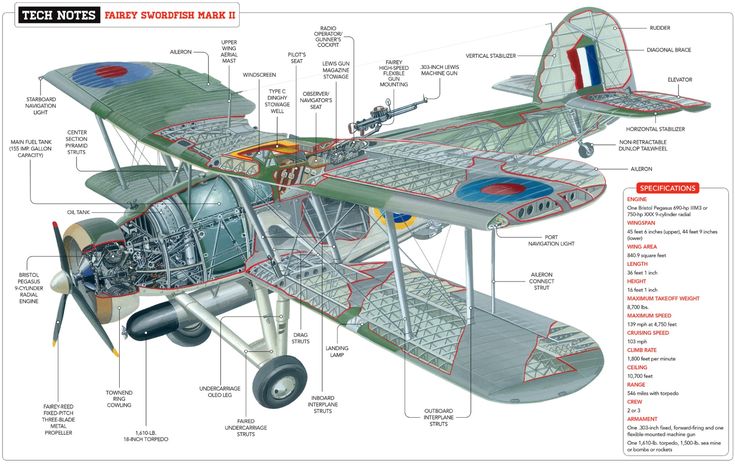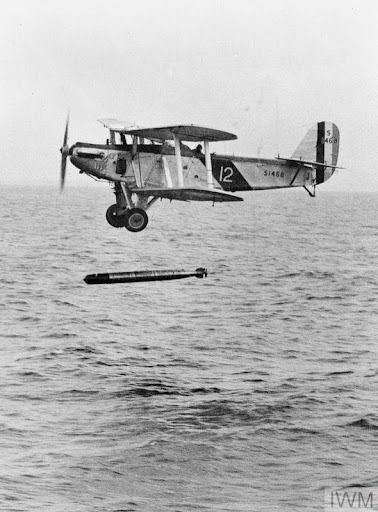Fairey Swordfish
Few aircraft in the history of military aviation have such a unique history as the Fairey Swordfish. This Royal Navy biplane torpedo bomber, affectionately known as the “Stringbag” (stringbag ww2) by its crews, may not have looked like a formidable war machine, but its impact on the course of the Second World War was colossal.
Fairey Swordfish: Armament

The Swordfish first entered service in 1936, at a time when metal monoplanes were beginning to dominate the skies. With fabric-covered wings, fixed landing gear and an open cockpit, the Swordfish seemed a relic of a bygone era. Its top speed was only 143 miles per hour – slower than many cars on today’s roads. Its armament was similarly modest, usually a single machine gun mounted in the rear, and ammunition was torpedoes or bombs.
Overcoming Expectations
Despite these limitations, the Swordfish became one of the most effective torpedo bombers of the war. It is credited with sinking far more Axis ships than any other Allied aircraft. The Swordfish’s first significant strike was during the 1940 Norwegian campaign, where it took the enemy by surprise, sinking several formidable German ships, including the dangerous submarine U64 and the torpedo boat Luchs.
Swordfish biplanes were resistant to anti-aircraft fire, and their fabric skin often absorbed hits without significant damage.
Legendary encounters

Destruction of the German battleship “Bismarck”
Perhaps the most famous episode of Swordfish’s service was her role in the destruction of the German battleship Bismarck in May 1941. During Operation Reyniubung, the Bismarck and the heavy cruiser Prinz Eugen set out to intercept Allied convoys in the North Atlantic. Following the tragic shipwreck of the Huda , the Royal Navy was desperate to stop the Bismarck before it could wreak further havoc.
In a daring raid, Swordfish bombers from HMS Ark Royal conducted a night torpedo attack that jammed the Bismarck’s rudder, leaving it sailing in circles. This critical damage allowed the Royal Navy to catch up with and eventually sink the German hulk, demonstrating Swordfish’s pivotal role in one of the most dramatic naval battles of the war.
The story of the destruction of the Bismarck deserves your attention, for a quick and easy study we recommend the short documentary attached in the resources.
The Battle of Taranto and Beyond
Swordfish also participated in the Battle of Taranto in November 1940 , a daring night raid against the Italian fleet that foreshadowed the Japanese attack on Pearl Harbor by more than a year. Flying from the aircraft carrier HMS Illustrious, Swordfish launched a surprise attack that disabled three Italian battleships and shifted the balance of naval power in the Mediterranean in favor of the Allies.
A legacy of underestimation and triumph

The Swordfish’s success throughout the war was due to a combination of its unexpected capabilities and the ingenuity and bravery of its crews. Its low speed and low approach altitude made it a difficult target for faster enemy aircraft and more sophisticated anti-aircraft systems, which were designed for much higher speeds.
In an age of rapid technological advancement, the Fairey Swordfish serves as a reminder of the enduring value of simplicity and reliability. Often underestimated, the Stringbag exceeded expectations and played a decisive role in some of the most significant naval engagements of World War II.
Conclusion

When we reflect on stories of the past, the story of Fairey Swordfish encourages us to look beyond appearances and appreciate the power of resilience and strategic ingenuity. His legacy continues to inspire and remind us that sometimes the most unassuming characters can have the greatest impact.
Movies:
https://www.youtube.com/watch?v=OIf7vLeGa70
Duration 27 minutes
Documentary. Personal explanation of the pilots about the success of this airplane.
https://www.youtube.com/watch?v=QIf7wMOGFM0
Duration 10 minutes
Documentary. Reveals the complex operations of carrier flying, focusing on the careful preparation and coordination required for takeoffs and landings.
https://www.youtube.com/watch?v=PF5FbTYtg2Q
Duration 12 minutes
Documentary.
Museums:
https://underwatermalta.org/discover/fairy-swordfish/
Underwater Malta Virtual Museum (go to website) – Here you will find a detailed description and 3D model of the submerged Fairey Swordfish. The Virtual Museum is a key resource for learning about Malta’s underwater artifacts.
https://www.maltaaviationmuseum.com/
Here you can learn about the history of this aircraft, its strategic importance and unique features.
Dive with Buddy Boat
At Buddy Boat, we believe that traveling to underwater relics is not only an exciting adventure, but also an opportunity to learn history by experiencing it firsthand.
Book our tours to the Fairey Swordfish sinking site. This experience will allow you to see the aircraft with your own eyes and feel the connection of the times when these machines were in service.
Read about the Fairey Swordfish dive site here: https://diveboat.mt/malta-dive-sites/fairey-swordfish/

